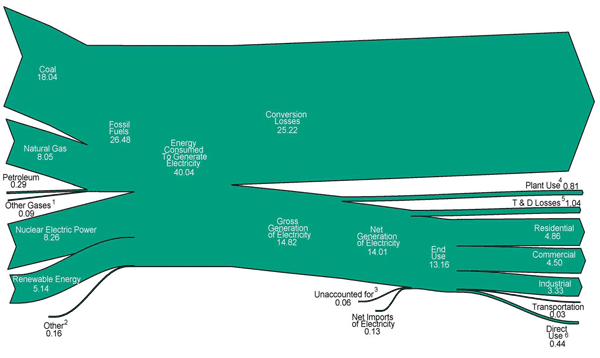Annual Energy Review
September 2012 PDF | previous editions
Release Date: September 27, 2012
Electricity Flow, (Quadrillion Btu)

Footnotes:
1 Blast furnace gas, propane gas, and other manufactured and waste gases derived from
fossil fuels.
2 Batteries, chemicals, hydrogen, pitch, purchased steam, sulfur, miscellaneous technologies,
and non-renewable waste (municipal solid waste from non-biogenic sources, and tire-derived
fuels).
3 Data collection frame differences and nonsampling error. Derived for the diagram by
subtracting the "T & D Losses" estimate from "T & D Losses and Unaccounted for" derived from Table 8.1.
4 Electric energy used in the operation of power plants.
5 Transmission and distribution losses (electricity losses that occur between the point of
generation and delivery to the customer) are estimated as 7 percent of gross generation.
6 Use of electricity that is 1) self-generated, 2) produced by either the same entity that
consumes the power or an affiliate, and 3) used in direct support of a service or industrial
process located within the same facility or group of facilities that house the generating equipment.
Direct use is exclusive of station use.
Notes:
• Data are preliminary.
• See Note, "Electrical System Energy Losses," at the end of Section 2.
• Net generation of electricity includes pumped storage facility production minus energy used for pumping.
• Values are derived from source data prior to rounding for publication.
• Totals may not equal sum of components due to independent rounding.
Sources:
U.S. Energy Information Administration, Annual Energy Review 2011 Tables 8.1, 8.4a, 8.9, A6 (column 7), and U.S. Energy Information
Administration, Form EIA-923, "Power Plant Operations Report."
